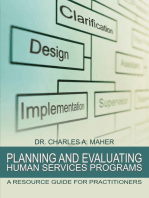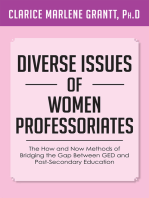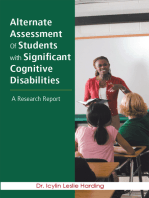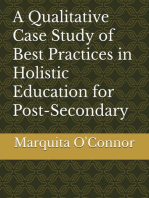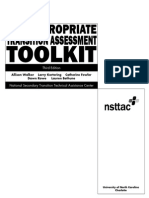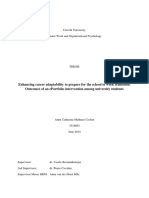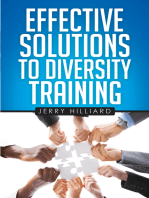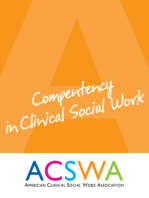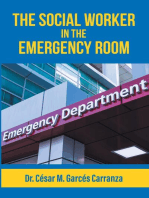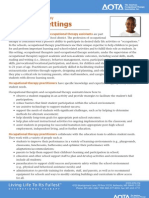Child-Based Research Review 526
Uploaded by
api-212210463Child-Based Research Review 526
Uploaded by
api-212210463Running Head: OCCUPATIONAL THERAPY AND SECONDARY TRANSITION SERVICES
Occupational Therapy and Secondary Transition Services Corinne Trenholm Touro University Nevada
OCCUPATIONAL THERAPY AND SECONDARY TRANSITION SERVICES
PICO question Are occupational therapists around the United States participating in secondary transition services for students with disabilities? How This Study Relates to PICO Question During my fieldwork at Opportunity Village I was astonished that occupational therapists werent involved in secondary transition services. When I talked to high school teachers they discussed that many of their students dont have occupational therapy services listed on their Individualized Education Plan (IEP). If an occupational therapist is listed as a service provider they arent involved with transition services. One high school teacher discussed that the occupational therapists at her school mainly works on handwriting skills. This is further shocking because Part B of IDEA clearly states that students between the ages of 14-22 years with an IEP must have a transition plan that is focusing on helping students prepare to move from high school to a post-school setting (Kardos & White, 2005). This was consistent for the students that have graduated high school but are still served by the Clark County School District (CCSD). The CCSD has teamed up with Opportunity Village to create a program called Job Discovery Training. This four year program allows students to experience different job training opportunities such as working in a kitchen, warehouse, thrift store, and janitorial services. The goal is for these students to gain the needed experience to obtain community employment when they turn 22 years old. It was shocking to learn that not one of these students had an occupational therapist as part of their team nor did Opportunity Village employ occupational therapists to help train staff and work with the students.
OCCUPATIONAL THERAPY AND SECONDARY TRANSITION SERVICES
Occupational therapists have the specialized training and skills to support educators and students with transition services. This disbelief that occupational therapists arent involved in this critical area of a young adults life led me to my PICO question and current research article. I wanted to find out if occupational therapys role in transition planning is understood and utilized by other school districts in the United States. Based on the findings in this article the CCSDs lack of use of occupational therapists in transition planning is a similar problem in districts around the country. Research Question This article attempts to identify the role of the school-based occupational therapist in secondary education transition. Purpose The purpose of this study was to determine the extent to which occupational therapists around the United States are engaged in secondary transition services. The researchers focused their study on school-based occupational therapists who work with students between the ages of 13-21 years of age. They investigated these occupational therapists knowledge about transition planning, assessment and intervention implementation for transition, and barriers to transition services. Through these focus areas the researchers were able to uncover the current role of occupational therapist in regard to secondary transition planning (Kardos & White, 2005). Research Design, Level of Evidence, & Measures Used In order to investigate the engagement of occupational therapists in secondary transition services, the researchers chose a quantitative, non-experimental research design. This type of research design is considered to provide a low level of evidence.
OCCUPATIONAL THERAPY AND SECONDARY TRANSITION SERVICES
Using survey research, one of researchers who specializes in school-based transition services, developed the survey questionnaire. The eight-page questionnaire included structured and open-ended questions consisting of 50 items. Questions included were intended to identify the degree in which occupational therapists: (a) understand transition services as outlined by IDEA; (b) participate in IEP transition planning; (c) feel they have the professional skills to support transition planning; and (d) perceive barriers to participating in transition services. The questionnaire was reviewed by professionals who are familiar with secondary transition mandates and school-based practice (Kardos & White, 2005). Interventions Due to this study being non-experimental no interventions were implemented. Participants (Recruitment & Selection, Drop-Out Rate, Numbers, & Demographics) The researchers utilized the School System Special Interest Section (SSSIS) of the American Occupational Therapy Association to select their participants. The researchers located 890 occupational therapists members working with students between the ages of 13-21 years. Members represented the 44 states along with the District of Columbia and Puerto Rico. Of these 890 occupational therapists, 400 were randomly selected to participate in the study. The researchers received a 20% response rate. Out of the 400 randomly selected participants, 80 returned their questionnaires. With the nature of this study design, no participants dropped out/requested their survey be pulled from the study. According to the researchers, these 80 participants represent all geographical regions in the United States. Other than the sample being members of the American Occupational Therapy Association and
OCCUPATIONAL THERAPY AND SECONDARY TRANSITION SERVICES
representing the United States, no other information about the participants was given including race, religion, age, and gender (Kardos & White, 2005). Group Assignment & Variables This study is non-experimental; therefore, no control or experimental groups were utilized. This type of study design also doesnt incorporate the use of independent and dependent variables. Statistical Analysis The researchers collected data over a period of three months. They interpreted this data using descriptive statistical analysis. Using SPSS 11.0 statistical software the researchers were able to answer their questions regarding an occupational therapists knowledge about transition planning, assessment and intervention implementation for transition, and perceived barriers to secondary transition planning (Kardos & White, 2005). Findings Although most occupational therapists reported that they understood terminology associated with secondary transition planning outlined in IDEA, only 47% of these therapists understood the overall intent of transition planning (Kardos & White, 2005). This significant finding is summed up by the researchers with the following statement: This contrast between a strong understanding of transition planning terminology and a weaker understanding of the purposes of secondary transition highlights the potential gap in current school-based practice and may help to explain why so few therapists reported practicing more broadly in this area (Kardos & White, 2005, p. 177).
OCCUPATIONAL THERAPY AND SECONDARY TRANSITION SERVICES
When examining data related to assessment implementation for transition planning, the researchers found three areas that are of concern. First, fewer than half of the participants reported that they are completing assessments that are used to help develop IEP goals and objectives related to transition planning. Second, when the therapists are involved in transition planning, the majority of participants arent assessing the four transition areas under IDEA. These include: (a) post-secondary education, (b) community participation, (c) post-secondary employment, and (d) residential outcomes. Finally, the therapists that are conducting transition planning assessments are more frequently utilizing informal assessments such as observations. The researchers discuss that lacking standardized assessments not only impacts an occupational therapists ability to measure functional occupational performance but also prevents them from developing effective transition goals, objectives, and strategies (Kardos & White, 2005). Occupational therapists who participated in the study reported providing more interventions related to transitioning than administering assessments for planning. Looking at the four transitional areas, 65% of the participants provided the most intervention in the area of post-secondary education. This means that the majority of the therapists focused on helping students prepare for education after leaving high school. This can involve preparation for college, trade school, or vocational school. Community participation and post-secondary employment were the next highest transition areas, with 45% of therapists providing interventions in these two areas. Community interventions focus on IADLs such as shopping, transportation, and conducting personal business. Post-secondary employment involves students working in a competitive or supported employment. Participants reported to provide the least intervention in the area of residential outcomes. Only 25% of therapists reported to work with students on independent living (Kardos & White, 2005).
OCCUPATIONAL THERAPY AND SECONDARY TRANSITION SERVICES
There were several barriers that participants identified in relationship with occupational therapists being involved in transition services. According to the participants, occupational therapists arent engaging in transition services because these services are being handled by a different professional on the students team such as the sspecial education teacher. Due to occupational therapy not being understood, other professionals take the lead role in this area. When occupational therapy is understood however, there are financial barriers allowing occupational therapists to provide services. Other barriers include occupational therapists lack of knowledge about transition services and heavy caseloads (Kardos & White, 2005). Heavy caseloads not only interfere with devoting time to professional development and growth but also to providing effective individualized intervention. Finally, participants reported that many students exit occupational therapy services prior to turning 14 years (Kardos & White, 2005). With this knowledge, students are depending on other school-based therapists to assess and implement their transition services. Previous Research The findings of this research study are consistent with another study completed by Inge in 1995 that was discussed by the researchers in this article. Inges study also focused on surveying occupational therapists participation in transition services for students with disabilities. This study showed that of the 755 participants who worked with school-age children between the ages of 14-22 years only 33% of these therapists reported to contribute to transition planning. This study also showed that occupational therapy services decreased with age and community-based instruction for children 14-22 years was minimal. Occupational therapists also reported having little experience and training in secondary transition services (Kardos & White, 2005).
OCCUPATIONAL THERAPY AND SECONDARY TRANSITION SERVICES
Findings Support Hypothesis The researchers expected to see minimal involvement in secondary transition services by occupational therapists. Their findings support this hypothesis and they were also able to uncover reasons and barriers for the lack of occupational therapy participation in transition planning. Clinical Implications The researchers discuss that their findings support the need for occupational therapists working with students of transition age to partake in continuing education. Continuing education should include learning opportunities for appropriate transition assessments as well as how occupational therapists can expand their scope of practice to enhance secondary transition services. The researchers feel that occupational therapists also need to educate secondary transition teams about their scope of practice and how they can offer their skills to enhance transition services as well as how they can help assess progress (Kardos & White, 2005). Limitations The researchers discuss that the major limitation to this study was the low response rate they received. They discuss that limited resources prevented them from being able to complete follow-up mailings and extend their sample. They also feel their low response rate was due to the lengthy survey they developed (Kardos & White, 2005). Other limitations, not discussed, include the time frame that the researches decided to send out their survey. They sent out the surveys between the months of October and December. These months are busy for many individuals due to the holidays and this could have played a role in their low response rate. The researchers also limited their study to those involved with the American Occupational Therapy
OCCUPATIONAL THERAPY AND SECONDARY TRANSITION SERVICES Association and didnt involve certified occupational therapy assistants who may be involved with this population. Future Research The researchers discuss that further research is needed in order to understand and
enhance occupational therapy in secondary transition services. They discuss that future research should also include certified occupational therapy assistants (Kardos & White, 2005). Topics Not Addressed Based on the type of research design the following topics that are not addressed in this paper include: 1) difference between groups, 2) control & comparison groups, 3) outcome measures, 4) blind assignments, 5) reliability & validity of outcome measures, and 6) confounding factors. Strengths This study is powerful in that is shows a need for occupational therapists to become more involved in secondary transition planning. By showing this need therapists working with students between the ages of 14-22 years should become motivated to pursue appropriate training. This training will enhance knowledge and confidence in order to help occupational therapists take the lead in planning and implementation of transition services. This study also shows that therapists who are participating in transition services arent using appropriate evaluation and assessment tools. Appropriate tools are needed to assess occupational performance and develop effective goals and interventions. This information should further motivate school-based therapists to expand their use of informal and/or inappropriate assessments. Therapists need to use tools that are specifically developed for enhancing transition
OCCUPATIONAL THERAPY AND SECONDARY TRANSITION SERVICES
10
services. Lastly, this study can motivate occupational therapy students who want to work in school-based settings to specialize and advocate for students of secondary transition age. Sample Size & Weaknesses Due to the limited sample size there may not be enough data to support the current findings of this research article. Based on the American Occupational Therapy Association (AOTA) there were about 900 occupational therapists working with secondary transition age students when this study was conducted (Kardos & White, 2005). This suggests that only 8.9% of therapists working with students between the ages of 14-22 years were included in this study. This 8.9% also doesnt include certified occupational therapists and non-members of AOTA. Another weakness is the design type. This research design falls at the bottom of the pyramid according to the levels of evidence. Although non-research experimental designs provide beneficial information to influence practice; professionals may discount this articles findings. Finally, the researchers only briefly touched on possible ways to address the issue of minimal involvement of occupational therapists in secondary transition planning. This is an area that the researchers could have elaborated on to motivate, excite, and direct therapists in pursing more involvement in this area. Conclusion The Field of Occupational Therapy & Participation in Occupation According to IDEA and discussed by Kardos & White (2005), Transition services are a coordinated set of activities for a student with special needs that are designed within an outcomeoriented process that promotes movement from school to post-school activities including postsecondary education, vocational training, integrated employment, continuing and adult
OCCUPATIONAL THERAPY AND SECONDARY TRANSITION SERVICES education, adult services, independent living, and community participation (p. 173). This statement exemplifies that participating in secondary transition services falls under the scope of practice for occupational therapists. All areas of occupations can be addressed in transition
11
services and more school-based occupational therapists need to use their educational and clinical training to support students and school-based professionals in this area. Understanding that all areas of occupation, studied by occupational therapists, are closely aligned with mandated transition services should prompt school-based professionals to encourage occupational therapists to take the lead role in transition assessment and intervention. Professional Use I have worked with young children for over 12 years and this article along with my fieldwork experience has sparked my interest in working with older children and young adults. I have learned that there is a great need for more qualified professionals to support older students with transition services. If I decide to be a school-based occupational therapist I would only accept a position that allows me the opportunity to utilize my educational training to assist in secondary transition services. Presenting this research and my current experience gives me the ability to advocate for this population. This article reminds me of why I am becoming an occupational therapist; to identify a need in the community and serve that population.
OCCUPATIONAL THERAPY AND SECONDARY TRANSITION SERVICES
12
Reference Kardos, M., & White, B. (2005). The role of the school-based occupational therapist in secondary education transition planning: A pilot study. The American Journal of Occupational Therapy, 59(2), 173-180.
You might also like
- Inside Graduate Admissions: Merit, Diversity, and Faculty GatekeepingFrom EverandInside Graduate Admissions: Merit, Diversity, and Faculty Gatekeeping4/5 (1)
- ASWB Clinical Study Guide 2020-2021: Social Work Exam Prep with 450 Questions and Detailed Answer Explanations (New Outline and 3 Full Practice Tests)From EverandASWB Clinical Study Guide 2020-2021: Social Work Exam Prep with 450 Questions and Detailed Answer Explanations (New Outline and 3 Full Practice Tests)3/5 (1)
- The Multicontext Approach to Cognitive Rehabilitation: A Metacognitive Strategy Intervention to Optimize Functional CognitionFrom EverandThe Multicontext Approach to Cognitive Rehabilitation: A Metacognitive Strategy Intervention to Optimize Functional CognitionNo ratings yet
- Planning and Evaluating Human Services Programs: A Resource Guide for PractitionersFrom EverandPlanning and Evaluating Human Services Programs: A Resource Guide for PractitionersNo ratings yet
- From Leadership in School Organization to Pragmatic Research in Physical Education Professional DevelopmentFrom EverandFrom Leadership in School Organization to Pragmatic Research in Physical Education Professional DevelopmentNo ratings yet
- Evaluation of the Positive Behavior Support Program on Fourth-Grade Student Discipline InfractionsFrom EverandEvaluation of the Positive Behavior Support Program on Fourth-Grade Student Discipline InfractionsNo ratings yet
- Relationship Between Health Literacy Scores and Patient Use of the iPET for Patient EducationFrom EverandRelationship Between Health Literacy Scores and Patient Use of the iPET for Patient EducationNo ratings yet
- A Guide for Culturally Responsive Teaching in Adult Prison Educational ProgramsFrom EverandA Guide for Culturally Responsive Teaching in Adult Prison Educational ProgramsNo ratings yet
- Diverse Issues of Women Professoriates: The How and Now Methods of Bridging the Gap Between Ged and Post-Secondary EducationFrom EverandDiverse Issues of Women Professoriates: The How and Now Methods of Bridging the Gap Between Ged and Post-Secondary EducationNo ratings yet
- The Nexus: How Best Practices Provide an Answer to the Student Achievement ConundrumFrom EverandThe Nexus: How Best Practices Provide an Answer to the Student Achievement ConundrumNo ratings yet
- Alternate Assessment of Students with Significant Cognitive Disabilities: A Research ReportFrom EverandAlternate Assessment of Students with Significant Cognitive Disabilities: A Research ReportNo ratings yet
- Transitions For Children and Youth: How Occupational Therapy Can HelpNo ratings yetTransitions For Children and Youth: How Occupational Therapy Can Help3 pages
- A Grounded Theory Analysis of The Relationship Between Creativity and Occupational TherapyNo ratings yetA Grounded Theory Analysis of The Relationship Between Creativity and Occupational Therapy389 pages
- THE ROLE OF PROFESSIONAL DOCTORATES IN ADVANCING HIGHER EDUCATION AND WORK-BASED LEARNING: Applications in Health and Social CareFrom EverandTHE ROLE OF PROFESSIONAL DOCTORATES IN ADVANCING HIGHER EDUCATION AND WORK-BASED LEARNING: Applications in Health and Social CareNo ratings yet
- Effects of an Inclusion Professional Development Model on Inclusion Knowledge and Perceptions of Regular Middle School EducatorsFrom EverandEffects of an Inclusion Professional Development Model on Inclusion Knowledge and Perceptions of Regular Middle School EducatorsNo ratings yet
- Fairness in Educational and Psychological Testing: Examining Theoretical, Research, Practice, and Policy Implications of the 2014 StandardsFrom EverandFairness in Educational and Psychological Testing: Examining Theoretical, Research, Practice, and Policy Implications of the 2014 StandardsNo ratings yet
- The Effects of Employment On The Academic Performance of The Working Grade 12 Senior High School Students at STI Academic Center Las PiñasNo ratings yetThe Effects of Employment On The Academic Performance of The Working Grade 12 Senior High School Students at STI Academic Center Las Piñas26 pages
- Literature Review On School-To-Work TransitionNo ratings yetLiterature Review On School-To-Work Transition50 pages
- Environmental Health Noncompliance: A Sanitarian's Search for a New SystemFrom EverandEnvironmental Health Noncompliance: A Sanitarian's Search for a New SystemNo ratings yet
- Students' Voices Regarding Homework (Third Edition)From EverandStudents' Voices Regarding Homework (Third Edition)No ratings yet
- "Man-Up" Institute Guide: Motivating Attitudes That Nurture an Understanding of Your PotentialFrom Everand"Man-Up" Institute Guide: Motivating Attitudes That Nurture an Understanding of Your PotentialNo ratings yet
- Practice Trends With Adults With Autism Spectrum DisorderNo ratings yetPractice Trends With Adults With Autism Spectrum Disorder15 pages
- Improving Self-Perceiver Emotional IntelligenceNo ratings yetImproving Self-Perceiver Emotional Intelligence25 pages
- A Qualitative Case Study of Best Practices in Holistic EducationFrom EverandA Qualitative Case Study of Best Practices in Holistic EducationNo ratings yet
- Course Design for Public Health: A Competency Based ApproachFrom EverandCourse Design for Public Health: A Competency Based ApproachNo ratings yet
- Strategies to Explore Ways to Improve Efficiency While Reducing Health Care CostsFrom EverandStrategies to Explore Ways to Improve Efficiency While Reducing Health Care CostsNo ratings yet
- AgeAppropriateTransitionAssessmentToolkit 1-2015No ratings yetAgeAppropriateTransitionAssessmentToolkit 1-201557 pages
- Bridging The Gap With Generation Y and ZNo ratings yetBridging The Gap With Generation Y and Z15 pages
- Performance Evaluation School Based TherapistsNo ratings yetPerformance Evaluation School Based Therapists85 pages
- Enhancing Career Adaptability To Prepare For The School To Work Transition-CoolenNo ratings yetEnhancing Career Adaptability To Prepare For The School To Work Transition-Coolen23 pages
- The Truth About Homework from the Students' PerspectiveFrom EverandThe Truth About Homework from the Students' PerspectiveNo ratings yet
- "The Emergence and Application of Design-Based Research in Nursing Education"From Everand"The Emergence and Application of Design-Based Research in Nursing Education"No ratings yet
- Vocational Engagement Model: A Journey Into the Intersection of Different Disciplines to Reinvent the Job Placement ProcessFrom EverandVocational Engagement Model: A Journey Into the Intersection of Different Disciplines to Reinvent the Job Placement ProcessNo ratings yet
- Creative Fieldwork Solutions Shifting The Paradigm AotaNo ratings yetCreative Fieldwork Solutions Shifting The Paradigm Aota8 pages
- The Question of Competence: Reconsidering Medical Education in the Twenty-First CenturyFrom EverandThe Question of Competence: Reconsidering Medical Education in the Twenty-First CenturyNo ratings yet
- Essays in Holistic Social Work Practice: The Need for an Interdisciplinary ApproachFrom EverandEssays in Holistic Social Work Practice: The Need for an Interdisciplinary ApproachNo ratings yet
- Leaders in Succession: Rotation in International School AdministrationFrom EverandLeaders in Succession: Rotation in International School Administration1/5 (1)
- The Impact of Learning Management Systems on Student Satisfaction: Career Development Book Series, #6From EverandThe Impact of Learning Management Systems on Student Satisfaction: Career Development Book Series, #63/5 (1)
- The Impact on Algebra vs. Geometry of a Learner's Ability to Develop Reasoning SkillsFrom EverandThe Impact on Algebra vs. Geometry of a Learner's Ability to Develop Reasoning SkillsNo ratings yet
- The Care Process: Assessment, planning, implementation and evaluation in healthcareFrom EverandThe Care Process: Assessment, planning, implementation and evaluation in healthcareNo ratings yet
- Interventions Used Among School-Based Occupational Therapy Practitioners To Promote Student PerformanceNo ratings yetInterventions Used Among School-Based Occupational Therapy Practitioners To Promote Student Performance30 pages
- Muhammad Bin Razali-D4E4-School Resource Center 8No ratings yetMuhammad Bin Razali-D4E4-School Resource Center 88 pages
- Section I A. Name and Brief Description of The Activity ObservedNo ratings yetSection I A. Name and Brief Description of The Activity Observed6 pages
- Developing Strategic Management and Leadership Skills100% (1)Developing Strategic Management and Leadership Skills19 pages
- Gaurishankar Campus Questions 2081 FinalNo ratings yetGaurishankar Campus Questions 2081 Final6 pages
- Betty Neuman: A System Model Study Using An Evidence-Based TheoryNo ratings yetBetty Neuman: A System Model Study Using An Evidence-Based Theory15 pages
- CEB Insight Generation Case Competition - Preliminary Case Proposal Round BriefNo ratings yetCEB Insight Generation Case Competition - Preliminary Case Proposal Round Brief3 pages
- Research-Paper-Final-Revisions-BS-PSYCHNo ratings yetResearch-Paper-Final-Revisions-BS-PSYCH159 pages
- Appendix 1: Sarason Social Support Questionnaire (Short Form) SSQSRNo ratings yetAppendix 1: Sarason Social Support Questionnaire (Short Form) SSQSR3 pages
- CAPPD A Practical Guide To Interventions For Children Affected by Trauma (Rev 2-12) - 0No ratings yetCAPPD A Practical Guide To Interventions For Children Affected by Trauma (Rev 2-12) - 032 pages
- Vlplus 252 Influences Hattie Ranking Dec 2017No ratings yetVlplus 252 Influences Hattie Ranking Dec 20172 pages
- 31 Important Things You Should Say No' To For A Happier LifeNo ratings yet31 Important Things You Should Say No' To For A Happier Life25 pages
- The History of Psychoeducational ConsultationNo ratings yetThe History of Psychoeducational Consultation8 pages
- The Human Experience Is A Magnificent Tapestry Woven With Threads of Countless StoriesNo ratings yetThe Human Experience Is A Magnificent Tapestry Woven With Threads of Countless Stories2 pages
- Society's Influence and Perception of Body Image and Appearance 1No ratings yetSociety's Influence and Perception of Body Image and Appearance 112 pages
- Using TAM Model To Measure The Use of Social Media For Collaborative LearningNo ratings yetUsing TAM Model To Measure The Use of Social Media For Collaborative Learning6 pages
- TMP - 29682-Cameron, L & Bandler, D.G & Lebeau, M - The Emprint Method-62977549No ratings yetTMP - 29682-Cameron, L & Bandler, D.G & Lebeau, M - The Emprint Method-62977549147 pages
- EFT Guide for Authors_ Releasing Doubts as the Cornerstone of Self-SabotageNo ratings yetEFT Guide for Authors_ Releasing Doubts as the Cornerstone of Self-Sabotage12 pages
- Download ebooks file CTET Central Teacher Eligibility Test Child Development and Pedagogy 2020 Paper I & II 2nd Edition - eBook PDF all chapters100% (6)Download ebooks file CTET Central Teacher Eligibility Test Child Development and Pedagogy 2020 Paper I & II 2nd Edition - eBook PDF all chapters61 pages
- Thesis Statement For Negative Effects of Video Games100% (2)Thesis Statement For Negative Effects of Video Games5 pages





